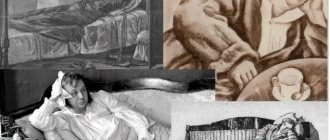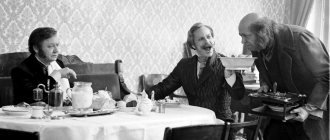January 18, 2017Literature
The moon and a thunderstorm, coffee and cigars, Stolz’s profession and Oblomov’s rank - we explain what Ivan Goncharov wanted to say with the help of details that are not always noticeable to the reader
Author Kirill Zubkov
Oblomov. Illustration by Konstantin Tikhomirov from the magazine “Pictorial Review of the Countries of the World.” 1883 © goncharov.spb.ru
The mystery of the thunderstorm
In the chapter “Oblomov’s Dream,” the author describes Oblomov’s favorable weather:
“Thunderstorms are not terrible, but only beneficial there: they occur constantly at the same set time, almost never forgetting Ilya’s day, as if in order to support a well-known legend among the people. And the number and force of blows seem to be the same every year, just as if a certain amount of electricity was released from the treasury for the entire region for a year.”
At first glance, this fragment seems almost random. The only thing that attracts attention is the mention of Elijah’s Day: “a well-known legend among the people” is the belief that you cannot work on Elijah’s Day, lest you be killed by thunder. Let us remember that the main character of the novel is called Ilya Ilyich - and he does not want to work not only on his angel day, but never at all. However, the thunderstorm in this passage is explained not only with the help of the popular belief about Elijah the Prophet as the patron of thunder - that is, through the eyes of a person who believes in the “well-known tradition.” The thunderstorm is presented simultaneously and rationally. The point of view of a resident of Oblomovka, who believes in the “well-known legend,” is, as it were, compared with the point of view of the rationalist Stolz: this hero has not yet appeared on the pages of the novel, but his voice, skeptical about popular superstitions, is already heard. This dual point of view will continue to define the narrative.
three lectures by Elena Vigdorova about “Oblomov” Goncharov
Overture to the novel "Oblomov"
What geometric figure does Goncharov use to depict sleep, paradise, harmony, peace and quiet?
"Oblomov": the search for man
How Oblomov exchanges his robe and sofa for lilac branches and what this change leads to
What is Oblomovism
How is Ilya Oblomov similar to Ilya Muromets and who do you need to be to get him off the couch?
The artistic originality of Goncharov’s novel “Oblomov”
In the novel “Oblomov,” Goncharov reflected part of his contemporary reality, showed types and images characteristic of that time, and explored the origins and essence of contradictions in Russian society of the mid-19th century.
The author used a number of artistic techniques that contributed to a more complete disclosure of the images, themes and ideas of the work. The construction of a literary work plays an important role, and Goncharov used composition as an artistic device. The novel consists of four parts; in the first, the author describes Oblomov’s day in detail, without omitting a single detail, so that the reader gets a complete and detailed picture of the main character’s whole life, because all the days in Oblomov’s life are approximately the same. The image of Oblomov himself is carefully outlined, and when the way of life and the features of the hero’s inner world are revealed and become clear to the reader, the author introduces “Oblomov’s Dream” into the fabric of the work, in which he shows the reasons for the emergence of such a worldview in Oblomov, the social conditioning of his psychology. Falling asleep, Oblomov asks himself: “Why am I like this?” - and in a dream he receives an answer to his question. “Oblomov’s Dream” is an exposition of the novel, located not at the beginning, but inside the work; Using such an artistic technique, showing first the character of the hero, and then the origins and conditions of his formation, Goncharov showed the foundations and depths of the soul, consciousness, and psychology of the protagonist. To reveal the characters' characters, the author also uses the technique of antithesis, which forms the basis for constructing a system of images. The main antithesis is the passive, weak-willed, dreamy Oblomov and the active, energetic Stolz. They are opposed to each other in everything, down to the details: in appearance, in upbringing, attitude to education, lifestyle. If Oblomov in childhood lived in an atmosphere of general moral and intellectual hibernation, which drowned out the slightest attempt to show initiative, then Stolz’s father, on the contrary, encouraged his son’s risky antics, saying that he would make a “good gentleman.” If Oblomov’s life proceeds monotonously, filled with conversations with uninteresting people, squabbles with Zakhar, copious amounts of sleep and food, endless lying on the sofa, then Stolz is always on the move, always busy, constantly in a hurry somewhere, full of energy. Actually, Stolz’s life, in his words, is a stormy, rushing river, while Oblomov’s life is a “swamp.” These are two completely opposite characters; Goncharov uses antithesis to more fully reveal the images of Oblomov and Stolz. In general, there are many oppositions in the novel, but the main ones are Oblomov and Stolz, Oblomov and Olga, Olga and Pshenitssha. The antithesis Oblomov - Olga is similar to the antithesis Oblomov - Stolz, only here the lethargy and indifference of Ilya Ilyich are contrasted with the liveliness and insatiable mind of Olga, which constantly requires new food for thought. Such curiosity and breadth of thinking, in turn, are contrasted with Pshenitsyna’s limitations and indifference. To show the sublimity of Olga and the down-to-earthness of Agafya Matveevna, in describing the heroines, Goncharov uses the following technique: speaking about Olga, he pays little attention to her appearance, dwelling in more detail on her inner world; in the description of Pshenitsyna, elbows, shoulders, neck are constantly mentioned - details of the external appearance; thus showing the insignificance and narrowness of her inner world and thinking. The comparison reveals the most typical and significant character traits; This creates a bright and relief image. The psychologism of the novel lies in the fact that the author explores the inner world of all the characters. To do this, he introduces internal monologues - the hero’s reasoning, which he does not say out loud. It’s like a dialogue between a person and himself; So, Oblomov before “Dream.” thinks about his behavior, about how someone else would behave in his place. The monologues show the hero’s attitude towards himself and those around him, towards life, love, death - towards everything; thus again psychology is explored. The artistic techniques used by Goncharov are very diverse. Throughout the novel, one encounters the technique of artistic detail, a detailed and accurate description of human appearance, nature, the interior decoration of rooms, that is, everything that helps the reader create a complete picture of what is happening. As a literary device in a work, symbol is also important. Many objects have symbolic meaning, for example, Oblomov’s robe is a symbol of his everyday life. At the beginning of the novel, the main character does not part with his robe; when Olga temporarily “pulls Oblomov out of the swamp” and he comes to life, the robe is forgotten; in the end, in Pshenitsyna’s house, it again finds use, until the end of Oblomov’s life. Other symbols - a branch of lilac (Olga's love), Oblomov's slippers (almost like a robe) and others are also of great importance in the novel. “Oblomov” is not only a socio-historical work, but also a deeply psychological one: the author set himself the goal not just to describe and examine, but to explore the origins, reasons for the formation, characteristics, and influence of a certain social type of psychology on others. I. A. Goncharov achieved this by using a variety of artistic means, creating with their help the most suitable form for the content - composition, system of images, genre, style and language of the work.
The mystery of the word "moon"
The narrator likes Oblomovka, but he doesn’t see anything poetic in her:
“God knows whether a poet or a dreamer would be content with the nature of a peaceful corner. These gentlemen, as you know, love to look at the moon and listen to the clicking of nightingales. <...> And in this region no one knew what kind of moon it was - everyone called it a month. She somehow good-naturedly looked at the villages and fields with all her eyes and looked very much like a cleaned copper basin.”
The poetic image of the moon is absent in Oblomov’s consciousness, and it is not by chance that we are told about this. The novel repeatedly mentions the aria "Casta diva" from Bellini's opera Norma. First, Oblomov dreams of how his future wife will perform it, and then Olga Ilyinskaya will perform this cavatina, after which Oblomov confesses his love to her. The name of the aria is translated into Russian as “The Most Pure Goddess,” but it is not dedicated to the Mother of God, as is sometimes claimed, but to the goddess of the moon. Oblomov himself remembers this:
“...how this woman’s heart is crying out! What sadness lies in these sounds!.. And no one knows anything around... She is alone... The secret weighs on her; she entrusts it to the moon..."
So, Oblomov’s love for Olga is associated with the romantic image of the moon - which, however, was not known in patriarchal Oblomovka. It is not surprising that the story of their relationship ends sadly.
The secret of Oblomov's love for Olga
After parting with Olga, Oblomov falls into a daze:
“Snow, snow, snow! - he repeated senselessly, looking at the snow that covered the fence, fence and ridges in the garden in a thick layer. - I fell asleep! “Then he whispered desperately, went to bed and fell asleep in a leaden, joyless sleep.”
Why couldn’t the hero talk about anything other than snow? Because Oblomov’s love for Olga develops in accordance with the seasons. The heroes meet in May, and a lilac branch becomes a symbol of their love - Oblomov directly compares his feelings with it several times. The relationship reaches its peak intensity in the summer, and in the fall Oblomov, depressed by numerous everyday difficulties, strives to avoid meetings with Olga, pretends to be sick, and so on.
When they part, it snows: the annual natural cycle is completed, and nothing can be done about it. Thus, in his love, the hero again turns out to be the product of his native village - a place where the “annual circle” repeats itself “correctly and calmly.”
The Mystery of Coffee and Cigars
Having daydreamed, Oblomov describes what he thinks is an ideal life to his only friend Stolz.
“Before lunch, it’s nice to look into the kitchen, open the pan, smell it, watch how the pies are rolled, the cream is whipped. Then lie down on the couch; the wife reads something new out loud; we stop and argue... But guests are coming, for example you and your wife. <…> After lunch, mocha, havana on the terrace...”
What does the mention of mocha coffee and Cuban cigars mean? To understand this, let’s pay attention to Stolz’s reaction: he listens attentively to his friend, but from the very beginning he is sure that even in his dreams Oblomov cannot come up with anything better than Oblomov: “You draw me the same thing that happened to our grandfathers and fathers.” Stolz is clearly wrong. The traditional, “Oblomov” way of life cannot satisfy the main character, and his dream cannot even be described in “Oblomov’s” words: coffee, cigars, terraces - all these are traces of studying at the university, books read. Oblomov, no matter how lazy he may be, is an educated Petersburger and has gone far from Oblomovka.
be like the potters
Instructions: how to write “Oblomov”
For example, come up with memorable names for the characters. Let everyone wonder what the surname “Oblomov” means
Mysteries of the Eastern War
Oblomov reads the newspapers and finds out “...why the British are sending ships with troops to the East...”.
What kind of military operations in the East do you mean? Most likely, the Anglo-Chinese “opium wars”, the consequences of which Goncharov personally observed during his stay in China and described in “The Frigate “Pallada””. However, this is not even the point. The sending of English troops to the East is mentioned at least four times in different places in the novel, and yet its action lasts several years. It turns out that not only the main character is stuck, as it were, in frozen time, where nothing happens, but also the world news (and the heroes of the novel love to discuss news) are the same all the time. Newspapers, seemingly obliged to follow the latest news, report on seemingly endlessly repeating events. Oblomov is not alone - the whole world cannot move from this point.
Essay on the topic: Oblomov - his essence, character and fate in I. A. Goncharov’s novel “Oblomov”
_________________________________________________________________________________________________ Composition. Oblomov - his essence, character and fate in I. A. Goncharov’s novel “Oblomov”
I.A. Goncharov wrote relatively few works, and “Oblomov” is one of the brightest. The novel touches on almost all aspects of human life, and answers to many questions can be found in it. Without a doubt, the most interesting image of the novel is the image of Oblomov. Who is he? “Master,” says Zakhar without a drop of doubt. Master? Yes. But which one? From the very first pages we see a portrait of Ilya Ilyich, drawn by the author himself. The first impression cannot be called repulsive, it is rather surprising, especially the words that “... lying down with Ilya Ilyich was a normal state,” and this is for a man “about thirty-two or three years old,” in the prime of his life! Compared to Stolz, Tarantyev, Volkov, he looks at least strange. But this is only at first, superficial glance. Oblomov gradually rises in our eyes from his sofa to the heights of Olympus as we approach the end of the novel. He appears as a completely different person, much more elevated than at the very beginning. So who is he really? How does he live? ... For many years now, Ilya Ilyich has been living in a dirty apartment on Gorokhovaya Street - he lives... For many years now he has been walking around in a robe and wide shoes - he lives. For many years he has been seeing light through dirty glass - he lives! So, all this - spacious clothes, a sofa, dust - is his ideal? Outwardly yes. But, in my opinion, what is much more important is the person as an individual, the person “from the inside.” And he himself admits this: “Give me a man, a man!” He loves people, but not all those who turn to high society. From the point of view of the lying philosopher, are these people? Is this life? “Either I don’t understand this life, or it’s no good,” he says. If we add to all this the gentleness that distinguishes Ilya Ilyich, then the ideal of the moral world of man appears before us. People with such convictions need to manage states, implement reforms, and not lie on sofas. But Oblomov acted in exactly the opposite way, because he does not have the strength to accomplish what he thinks and dreams about. But the most terrible thing, in my opinion, is that Ilya Ilyich himself is aware of his tragedy, he himself feels that “... it seems that he will never get out of the wilderness and onto the straight path.” There is nothing worse and heavier than the consciousness of one’s own powerlessness. Considering all that has been said, Oblomov for me is not just some kind of example of laziness. He is a hundred times better than all the Sudbinsky and Volkovskys combined. But, in my opinion, such a soul should under no circumstances be hidden under house arrest, thereby extinguishing it. such a soul must be opened up, taken beyond its own boundaries, so that it glows and sparkles, bringing benefit and joy to everyone around. Somewhere and sometime in his life, Oblomov was erased from this path. Maybe when he was overprotected in childhood, maybe when he became faint-hearted in the service. But the position that the main character occupies in the novel is, in any case, better than the position of representatives of high society. Observing through stories the lives and activities of other people, Oblomov asks the question: “When to live?” And he lives, but lives in his own way, thinking but doing nothing. This, in my opinion, is the essence of what Stolz called “Oblomovism”: a person thinks, reflects, builds the greatest humanistic plans, but as soon as it comes to implementation, he is overcome by elementary laziness, and he remains passive. Ilya Ilyich lives exactly this way, and he is happy in his own way. Of course, it seems strange that a person who has received an excellent education cannot connect two words in a letter. But the reason lies in the same apathy inherent in Oblomov since childhood. Still would! For a person who considers putting on stockings on his own a feat, writing a letter is the height of courage! If we remember that for Ilya Ilyich, life and science always went separately, and work and boredom were synonymous, then it becomes clear how he ended up on his sofa, in his robe. But still there is something in Oblomov that makes the same Stolz go to him after noisy receptions. And this cannot be called only a connection with childhood memories. Andrey is attracted to Ilya, first of all, in my opinion, by his soul, pure, open, sparkling. A soul that, besides Stolz, only Zakhar and much more Olga knew about. Oblomov generally differs from the entire high society, to which he undoubtedly belongs, in his view of it. He looks from the outside, carefully analyzing all the incidents. He is able to draw such deep conclusions that Stolz involuntarily exclaims: “You are a philosopher, Ilya!” In this context, Oblomov does not look like a missing person at all. What does Ilya Ilyich need? Yes, he wants peace and slowness to come to the whole world, as has long happened in himself. And everything that happens around him is “not life, but a distortion of the norm, the ideal of life, which nature indicated as a goal to man...” Oblomovism was Ilya Ilyich’s ulcer, an ulcer so strong that even love could not destroy it. No matter how much it seemed to us that the main character had changed, loving Olga, he returned to where he came from - to his sofa. Having felt all the tension of such an unusual life for him, faced with the hypocrisy of high society persons, Ilya Ilyich could no longer hope for anything other than a return “to the roots.” In his opinion, it is better to lie on his side all his life, preparing new and new plans, than to run around, fuss, and engage in empty chatter. So, through Oblomov, the couch potato, Oblomov, the philosopher, can be seen. This circumstance certainly raises him in our eyes. Indeed, in those days, it was very difficult for a person who in all respects belonged to high society to maintain purity and not succumb to general influence. Reading the novel by I.A. Goncharov aroused in me a variety of feelings regarding the main character. I am happy to see Oblomov’s bright, sparkling soul, his humanism, gentleness, and faith in man. But I condemn and cannot accept his apathy and laziness, which do not give wide use to a morally strong nature, which is the nature of Ilya Ilyich. Apparently, Oblomov’s whole fate is to think, think and... do nothing. In conclusion, I would like to say that Oblomov’s character and essence can be considered deeply national. For many centuries now, we have been thinking, thinking, looking around: “How is it going there?”, but we are doing little. We can only hope that we will avoid the fate of Oblomov, this lazy Russian philosopher, and, although with a pure soul, will not die somewhere on the outskirts, among chicken coops and cabbage. .
The Secret of the College Secretary
This is how the narrator introduces Oblomov to us:
“Oblomov, a nobleman by birth, a collegiate secretary by rank, has been living in St. Petersburg for twelve years without a break.”
A collegiate secretary is a rank of class X, that is, not the lowest. How could Oblomov receive such a rank? But this is really not very clear, even to the commentators of the Complete Works of Goncharov, who discovered this riddle. It can be assumed that Oblomov graduated from the university as a candidate, that is, with particular success, and received this rank immediately after graduation (only Oblomov did not study particularly diligently). If Oblomov was not a candidate, he should have the rank of XII class - provincial secretary. But we know that the hero “served somehow for two years,” which means he could not have time to serve two ranks. Moreover, in the drafts of the novel Oblomov is directly named as the provincial secretary. In general, there is no plausible explanation for Oblomov’s rank. It remains to be assumed that some other principle is at work here. It was the X class that Oblomov’s common-law wife, the widow Agafya Matveevna Pshenitsyna, had (wives and widows of officials were considered in the same rank as their husbands). Perhaps this coincidence is an ironic hint at the peculiar “kinship of souls” of Oblomov and Agafya Matveevna.
Artistic features of the novel “Oblomov” by I.A. Goncharov
“Oblomov” (1859) is a novel of critical realism, that is, it depicts a typical character in typical circumstances with correct details (this formulation of critical realism is given by F. Engels in a letter to M. Harkness in April 1888). Each talented writer expresses these principles of critical realism in his own way, creating an original literary work that is unlike any other. In “Oblomov,” Goncharov presented his understanding not of an individual side, but of the entire Russian life at a turning point in history - on the eve of the abolition of serfdom, when both social and moral contradictions became especially acute. To reveal the chosen topic, Goncharov describes in the novel the life of one character - Oblomov, a landowner and retired official, in whose life nothing special happens: he sleeps or dreams almost all the time, lying on the sofa, first in an apartment on Gorokhovaya Street, then on the Vyborg side , and when he’s not sleeping, he’s eating. Thus, there is very little action in the novel, there is no entertaining plot, no cunning intrigues, it even seems drawn out.
The exhibition occupies the first and the beginning of the second part of the novel (before Oblomov met Olga) and depicts almost one ordinary morning in the life of Ilya Ilyich. The main character's life is limited to one room, where he cannot get off the couch for the whole morning. But in the first part, in “Oblomov’s Dream,” the formation of Ilya Ilyich’s character is shown in detail. The noble origin and position of the landowner, for whom three hundred Zakharovs work, as well as the greenhouse upbringing turned the lively and inquisitive boy into a “superfluous person”, good for nothing, unable to do anything.
The plot of the novel is the acquaintance of the main character with Olga. The love story of Oblomov and Olga constitutes the main plot-forming line of the novel, but a second storyline develops in parallel - the story of the friendship of Oblomov and Stolz. The love story in the life of the protagonist was short-lived and, at first glance, very calm: there were no external obstacles to this love (except for the broken bridges that separated the lovers for two weeks - 3, VI), nothing prevented the union of young and loving people, except Oblomov's laziness and apathy. There are two climaxes in the love storyline: an explanation-confession in the lilac alley (2, VI) and the final explanation (3, XI), when both understand that they must separate. This second climax practically coincides with the denouement of the love story. However, the novel (Oblomov’s life) continues even after the break: in the fourth part, Goncharov depicts the sleepy existence of Ilya Ilyich in the house of the widow Pshenitsyna and his quiet death. Here is the culmination of the friendship story: Stolz takes control of Oblomovka and deals with the fake loan letter drawn up by the clever swindlers Mukhoyarov and Tarantiev. So Stolz actually proves his friendly disposition towards the main character, and Oblomov proves his complete helplessness, for the hero’s vital interests have narrowed to a hearty dinner and a long sleep. Consequently, there is nothing original in the plot of the novel: through the story of love and friendship, the character of both Onegin and Pechorin is revealed. However, these “older brothers” of Oblomov, as Dobrolyubov called them in the article “What is Oblomovism?” (1859), they commit at least some actions: they fight in a duel, try their luck, rush through life, trying to find a worthy occupation for themselves. In "Eugene Onegin" and "Hero of Our Time" clashes of characters are shown in specific circumstances, and in "Oblomov" a sleepy life reigns, which requires special techniques of artistic embodiment from the author. Goncharov found an original way to depict his hero - through details and objects, since Oblomov has neither actions nor business where he could express himself.
Dobrolyubov noted that the peculiarity of Goncharov’s style is the thoroughness of the description: “The author is not amazed by one side of an object, one moment of existence, but turns the object from all sides, which allows him to capture the full image of the object, mint it, sculpt it” (“What is Oblomovism? "). Goncharov draws in detail the robe, shoes, Ilya Ilyich's sofa, his dusty room, his awkward, inept servant Zakhar.
Objects become symbolic for Oblomov’s character. There are books on the table in his room, but they are pretty covered with dust. When the main character falls in love with Olga, he locks his wonderful robe, wide and warm, in the chest, which in the novel becomes a symbol of dead peace and sleep. But when Oblomov settles down on the Vyborg side, the robe is taken out of the chest, washed, darned by the hands of the caring housewife Agafya Matveevna, and this is already a signal that sleepy life has again defeated Ilya Ilyich. In “Oblomov’s Dream,” the author talks in detail about one day in Oblomovka: worries about dinner, the arrangement of the manor’s house, a dead sleep after dinner, evening gatherings of the noble family.
Gogol was also brilliant at showing the character of a hero through objects. Landowners in “Dead Souls” are portrayed satirically; the writer reduces the description of their dead souls to one main feature. For example, Sobakevich emphasizes thriftiness, thoroughness, and clumsiness. These similar features are manifested in the external appearance of the village and in the interior decoration of the landowner’s house: the huts, fences, even the well were built from such thick logs as are used only for ship masts, and the furniture in Sobakevich’s living room was simple, but strong and stable, like himself owner, similar to a medium-sized bear.
Goncharov does not repeat, but develops Gogol’s depiction techniques. Oblomov may be somewhat similar to Gogol’s landowners, but it is impossible to simplify his character and see in him only a primitive nature (“dead soul”). Goncharov shows a thinking person who wants to understand himself, dreams, loves. The main character trait of Oblomov - laziness - is revealed in many ways, that is, it is illuminated in different ways, from different points of view. As a result, the writer creates a complete and complex character of the main character, not limiting himself to the satirical sharpening of one or two traits.
In the novel, Goncharov shows the dying soul of the main character, therefore he conveys in detail the experiences of Ilya Ilyich. Goncharov’s psychologism is also special: through the description of objects and everyday details, the author depicts not the soullessness of Oblomov (as was the case with Gogol), but the contradictory struggle of his feelings and thoughts. The originality of the psychological disclosure of Oblomov’s image is manifested in the fact that Goncharov does not show the thinking process, like Tolstoy and Dostoevsky, but the hero’s already established stereotype of thoughts, which, like the surrounding objects, characterizes Ilya Ilyich. Indicative in this sense is the emergence of his interest, and then love for Agafya Matveevna: Oblomov began to take a closer look at his landlady after she treated him to a very tasty pie “with chickens and fresh mushrooms” (3, III). The pie reminded Ilya Ilyich of Oblomovka.
The hero’s mental well-being is often conveyed through his physical state. Anxiety, for example, is expressed by the fact that Oblomov is spinning on his sofa: “At times he was lost in the tide of everyday worries, he lay, tossing and turning from side to side, at times his abrupt exclamations could be heard: “Oh, my God! Touches life, touches everywhere” (1, I). As if wanting to hide from a hectic life, Oblomov “wrapped himself in a robe or wrapped his head completely in a blanket.” But then a thought awoke, a moment of self-criticism came, and “Oblomov freed his head from under the blanket” (1, VIII). Usually, Ilya Ilyich’s emotional experiences are accompanied by a painful physical state: he talks to Olga, and his “arms and legs grew cold,” “he lost heart,” “a slight fever was already breaking out inside him” (2, XII).
One of the artistic features of the novel is the interweaving of lyrical, tragic and comic images. Dobrolyubov noted that Goncharov’s writing style is unobtrusive; he does not teach the reader how to understand the character or situation described in the novel: Goncharov “doesn’t care about the reader and the conclusions you draw from the novel - that’s your business” (“What is Oblomovism?”). But with all the objectivity of the description, Goncharov feels deep sympathy for the main character, condescension towards him, dictated by a clear understanding of the evil that destroyed him. It is known that at first the novel was called “Oblomovshchina,” that is, the ideological emphasis was placed on the social circumstances that shaped the lazy, worthless character of the hero. However, in the final version, Goncharov changed the title to “Oblomov,” thereby emphasizing the importance of the hero’s personal drama.
There is comedy in the first part of the novel, when Oblomov cannot get up from the sofa, although he has already put his feet down to his slippers several times. Every time some thought stopped the hero and, in order to think about it, he again lay down on the pillow. Already in the first part, Oblomov poses a cardinal question: “Why am I like this?” (1,VIII). From this moment on, a tragic mood arises in the novel, which gradually intensifies towards the end: Oblomov, an intelligent, conscientious and sensitive person, but weak-willed and passive, cannot overcome his nature and quickly moves towards a tragic ending, fully aware of it. The author shows Oblomov through the struggle of opposing aspirations: this struggle from time to time leads the hero to a painful awareness of his helplessness and the desire to change his life, but all impulses end in apathy, sleep, and the victory of laziness. Unfortunately, of the two possible paths that Oblomov himself sees before himself (“Now or never! To be or not to be!” 2, V), the second one wins - “never”, “not to be”. Oblomov gives up active life and voluntarily limits his existence to worries about a tasty dinner and peace in a house on the Vyborg side. The author's lyrical notes sound most strongly in the fourth part of the novel: here the author's sympathy for the helpless hero is clearly expressed.
To summarize, it should be said that the novel “Oblomov” is a highly original work, deep in ideological content and unique in the artistic embodiment of this content. The novel is structured very simply, without spectacular plot twists. Its value does not lie in its outward entertainingness, but in the depth of its understanding of Goncharov’s contemporary Russian reality and human life in general. After all, Oblomov is shown simultaneously as a product of certain social conditions (Oblomovism) and as a person who is trying to resist them, not accepting the empty and vain surrounding reality. Social status (landowner), incorrect upbringing (from childhood it was instilled in him that work is punishment, and rest and peace are fabulous bliss) predetermined, according to Goncharov, the tragic fate of the protagonist. However, rejection of life led to a tragic end in all eras: circumstances defeated a proud person who opposed himself to the unjust world around him. It is not for nothing that Hamlet’s dilemma is repeated in Oblomov, and Oblomov himself and Zakhar resemble Don Quixote and Sancho Panza. The Spanish knight also went “against the flow” and because of this he caused laughter among “normal” people who know in advance that going against the flow is stupid - you will still lose.
The author’s attitude towards such a complex and contradictory hero as Oblomov is very ambiguous: Goncharov shows not only his negative traits (laziness, parasitic morality, inertia, selfishness), but also positive ones (intelligence, sensitivity, decency, understanding of nature, respect for women) . This determines the interweaving of comic, tragic, lyrical images in the image of the main character.





